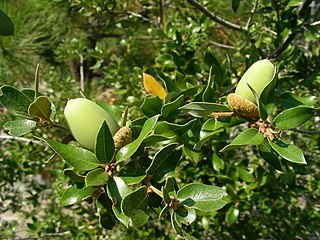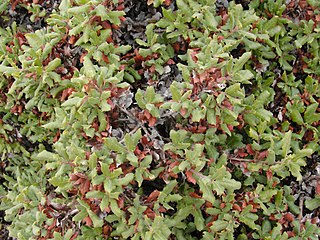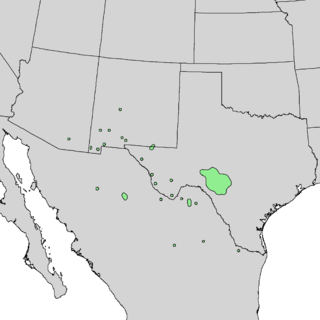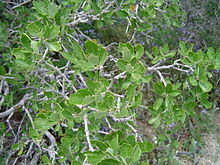
Pseudotsuga macrocarpa, commonly called the bigcone spruce or bigcone Douglas-fir, is an evergreen conifer native to the mountains of southern California. It is notable for having the largest cones in the genus Pseudotsuga, hence the name.

Quercus kelloggii, the California black oak, also known as Kellogg oak, is an oak in the red oak section, native to western North America. Although genetically separated from them for more than 20 million years, its leaves are remarkably similar in appearance to several other members of the red oak section including the red oak and the black oak found in eastern and central North America.

Quercus agrifolia, the California live oak, or coast live oak, is a highly variable, often evergreen oak tree, a type of live oak, native to the California Floristic Province. May be shrubby, depending on age and growing location, but is generally a medium sized tree. It grows west of the Sierra Nevada mountain range from Mendocino County, California, south to northern Baja California in Mexico. It is classified in the red oak section of oaks.

Quercus wislizeni, known by the common name interior live oak, is an evergreen oak, highly variable and often shrubby, found in many areas of California in the United States continuing south into northern Baja California in Mexico. It generally occurs in foothills, being most abundant in the lower elevations of the Sierra Nevada, but also widespread in the Pacific Coast Ranges ─ where since 1980 it has been known as a separate species Quercus parvula ─ and the San Gabriel Mountains. It was named for its collector, Friedrich Adolph Wislizenus (1810–1889).

Quercus douglasii, known as blue oak, is a species of oak endemic to California, common in the Coast Ranges and the foothills of the Sierra Nevada. It is California's most drought-tolerant deciduous oak, and is a dominant species in the blue oak woodland ecosystem. It is occasionally known as mountain oak and iron oak.

Quercus tomentella, the island oak, island live oak, or Channel Island oak, is an oak in the section Protobalanus. It is native to six islands: five of the Channel Islands of California and Guadalupe Island, part of the State of Baja California.

Quercus gambelii, with the common name Gambel oak, is a deciduous small tree or large shrub that is widespread in the foothills and lower mountain elevations of western North America. It is also regionally called scrub oak, oak brush, and white oak.

Quercus coccifera, the kermes oak, is an oak bush in the Quercus section Cerris. It is native to the Mediterranean region and Northern African Maghreb, south to north from Morocco to France and west to east from Portugal to Cyprus and Turkey, crossing Spain, Italy, Libya, Balkans, and Greece, including Crete. The Kermes Oak was historically important as the food plant of the Kermes scale insect, from which a red dye called crimson was obtained. The etymology of the specific name coccifera is related to the production of red cochineal (crimson) dye and derived from Latin coccum which was from Greek κόκκος, the kermes insect. The Latin -fera means 'bearer'.

Quercus engelmannii, the Engelmann oak or Pasadena oak, is a species of oak in the white oak section, native to southern California and northwestern Baja California, Mexico.

Quercus chrysolepis, commonly termed canyon live oak, canyon oak, golden cup oak or maul oak, is a North American species of evergreen oak that is found in Mexico and in the western United States, notably in the California Coast Ranges. This tree is often found near creeks and drainage swales growing in moist cool microhabitats. Its leaves are a glossy dark green on the upper surface with prominent spines; a further identification arises from the leaves of canyon live oak being geometrically flat.

Quercus durata, commonly known as leather oak, is a species of oak endemic to California, common in the Coast Ranges and the foothills of the Sierra Nevada. The common name "leather oak" is derived from the leathery texture on the lop of its leaves. Taxonomically it is placed in the white oak group.

Quercus dumosa is a species of plant in the family Fagaceae, belonging to the white oak section of the oak genus (Quercus). This tree goes by the common names coastal sage scrub oak and Nuttall's scrub oak.

Quercus × macdonaldii, formerly Quercus macdonaldii, with the common names MacDonald's oak and Macdonald oak, is a rare species of oak in the family Fagaceae.

Quercus vacciniifolia, the huckleberry oak, is a member of the Protobalanus section of genus Quercus. It has evergreen foliage, short styles, very bitter acorns that mature in 18 months, and a woolly acorn shell interior.

Quercus cornelius-mulleri is a North American species of oak known by the common name Muller oak, or Muller's oak. It was described to science in 1981 when it was segregated from the Quercus dumosa complex and found to warrant species status of its own. It was named after the ecologist Cornelius Herman Muller. It is native to southern California and Baja California, where it grows in chaparral, oak woodlands, and other habitat in foothills and mountains. It can most easily be observed in Joshua Tree National Park and in the woodlands along the western margins of the Colorado Desert in San Diego County, California.

Quercus john-tuckeri is a North American species of oak known by the common name Tucker oak, or Tucker's oak. It is endemic to California, where it grows in the chaparral and oak woodlands of mountain slopes in the western Transverse Ranges, the southernmost Central Coast Ranges, and the margins of the Mojave Desert. The species is named after John M. Tucker, professor of botany (1947-1986) at the University of California at Davis, specialist in Quercus.

Quercus turbinella is a North American species of oak known by the common names shrub oak, turbinella oak, shrub live oak, and gray oak. It is native to Arizona, California, New Mexico, Utah, Colorado, and Nevada in the western United States. It also occurs in northern Mexico.

Quercus pacifica is a species of oak known by the common names island scrub oak, Channel Island scrub oak, and Pacific oak.

Quercus pungens, commonly known as the sandpaper oak or scrub oak, is a North American species evergreen or sub-evergreen shrub or small tree in the white oak group. There is one recognised variety, Quercus pungens var. vaseyana, the Vasey shin oak. Sandpaper oak hybridizes with gray oak in the Guadalupe Mountains of New Mexico and Texas.

Quercus geminata, commonly called sand live oak, is an evergreen oak tree native to the coastal regions of the subtropical southeastern United States, along the Atlantic Coast from southern Florida northward to southeastern Virginia and along the Gulf Coast westward to southern Mississippi, on seacoast dunes and on white sands in evergreen oak scrubs.





















